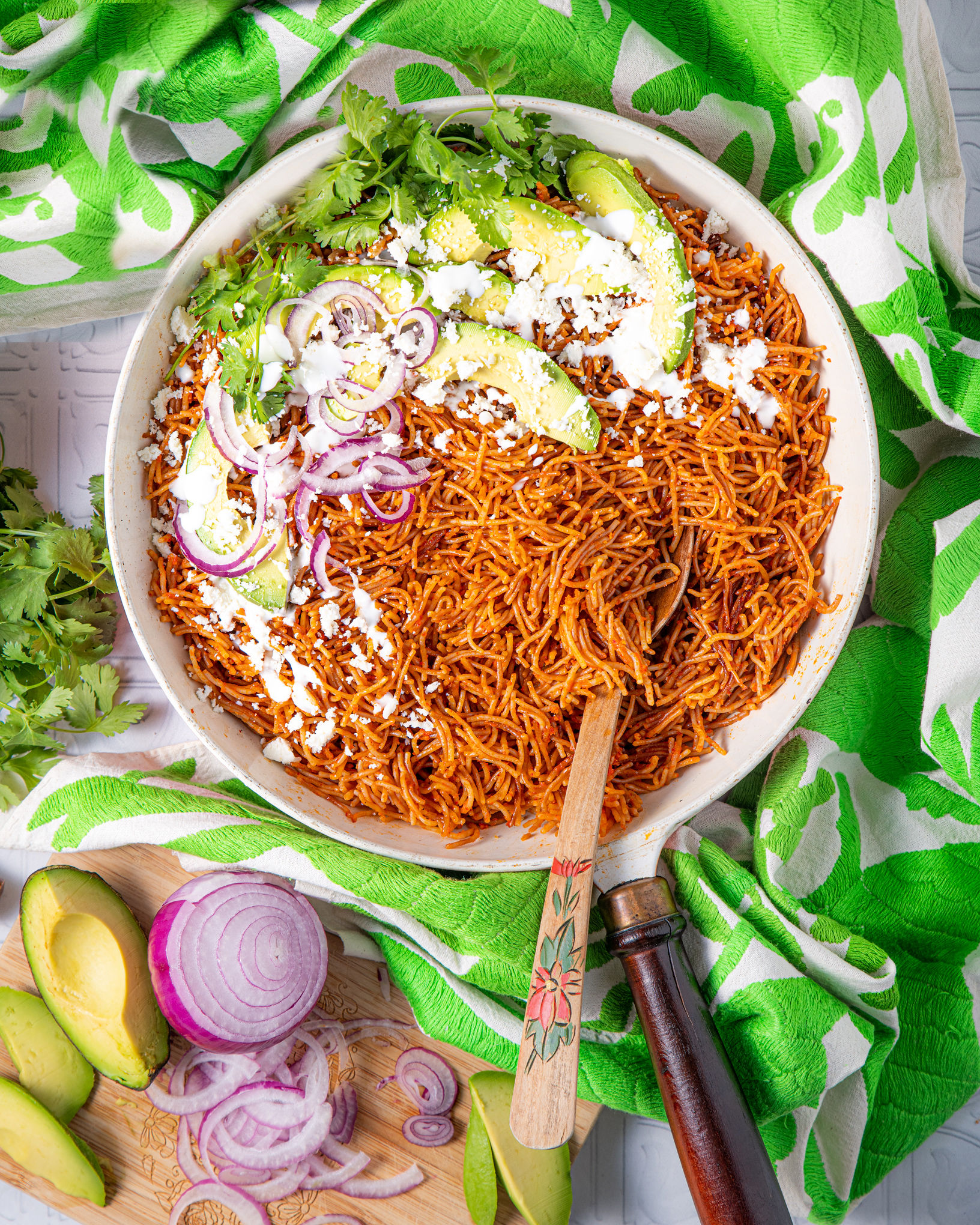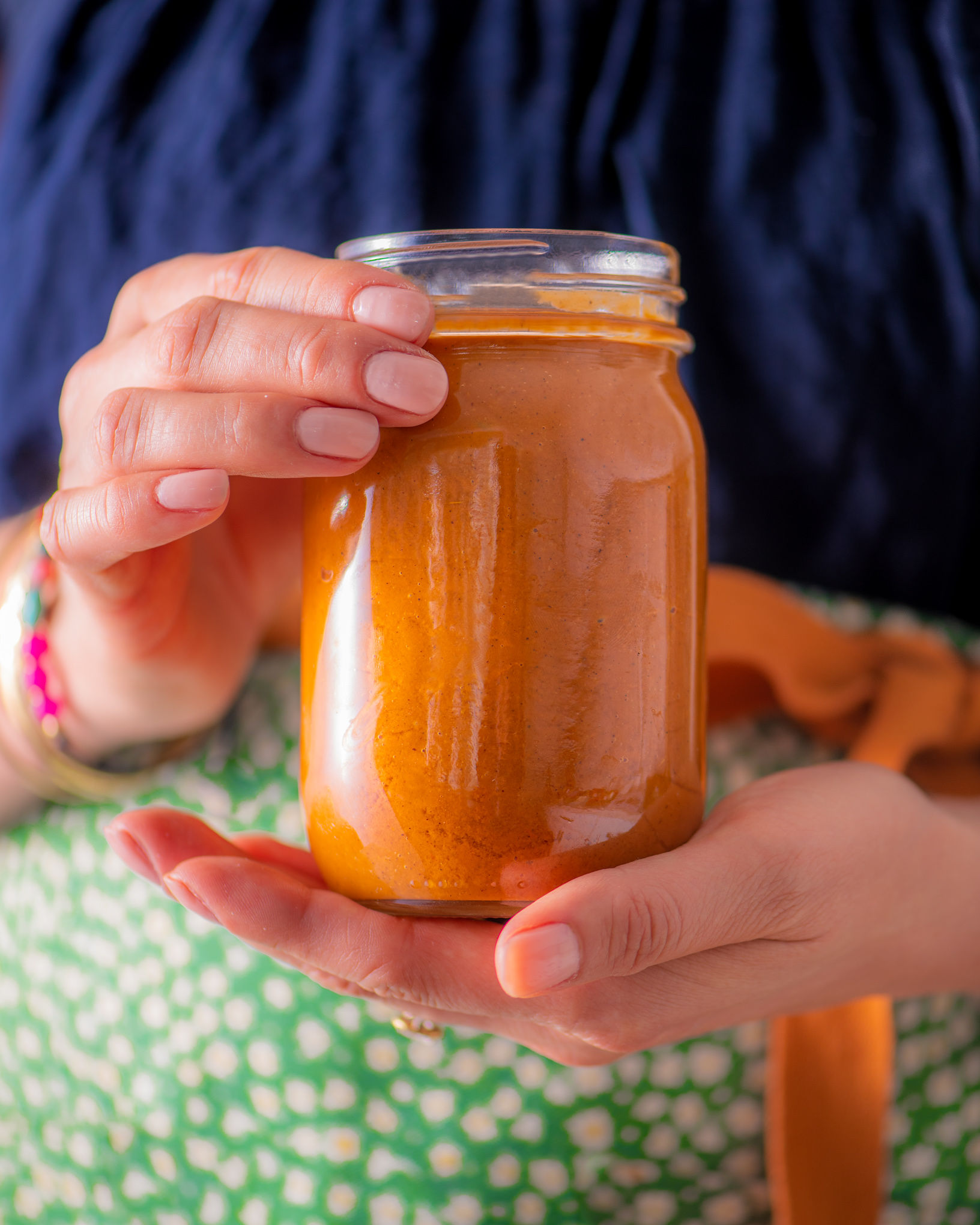Fideo Seco
If you’re looking for the best Fideo Seco recipe, look no further. Fideo Seco is a comforting Mexican pasta dish inspired by my travels to Oaxaca. In this recipe, fideo noodles are toasted in oil to enhance their rich, nutty flavor, then slowly simmered in a luscious tomato broth infused with guajillo peppers.

The first time I visited Oaxaca in 2006, it was truly a trip for my tastebuds. Tlayudas, tetelas, and tejate were all new to me. The dish that I dreamed about for over 15 years though, was fideo seco and after much trial and error, I’ve finally learned how to make fideo seco, al estilo Oaxaca, and have perfected the recipe!

WHY I LOVE THIS RECIPE
Homemade tomato sauce: My Mexican Tomato Sauce is much more flavorful than store-bought options and is my go-to when making this pasta.
Great texture and flavor: Mexican fideo seco is made by simmering fried noodles in a luscious and savory tomato sauce, which then absorb the flavors, creating an amazing texture.
Versatile: This sopa de fideo seco can be dressed up with a variety of garnishes like avocado, crema, queso fresco, and so much more.
Budget-friendly: this easy recipe calls for simple, easy-to-find, and affordable ingredients, including fideo noodles, which typically cost no more than $1 per 7-ounce bag. You can easily make Fideo Seco for a crowd as a main dish or hearty side.
WHAT IS FIDEO SECO?
Not to be confused with sopa de fideo, also known as sopita, which is soupy, this Mexican pasta recipe works well as a side dish or main entree when served with all of the toppings. Traditional fideo seco is prepared similar to Mexican red rice, only this dish uses dry fideo noodles that are first toasted in oil and then simmered with a tomato-based broth until all of the liquid is absorbed.
Just so we’re clear, this is not, I repeat, NOT sopa de fideo on day two after it absorbs all of the broth (if this happens to you and you want to know the secret to keeping your sopa de fideo nice and soupy, check out my 5 tips and tricks to the perfect sopa de fideo).
INGREDIENTS
- Fideo: For authentic fideo seco, I like to use the thicker Mexican pasta that is simply labeled, “Fideo.” I avoid making fideo secowith vermicelli because they are much thinner and burn too easily in this recipe.
- Onion and Garlic: These aromatics are sautéed in oil to bring out their amazing flavors.
- Roma Tomatoes: Choose ripe, plump tomatoes that are a deep red and are firm but with a slight give under pressure.
- Guajillo Chile: The dried chile adds a little kick and is reminiscent of the fiery fideo I loved in Oaxaca.
- Oil: Oil is used to sauté the onion and garlic and to toast the fideo noodles.
- Broth: You can use chicken broth or use vegetable broth to keep it vegan.
- Salt and Pepper
TOOLS, SUPPLIES, AND EQUIPMENT
- Knife
- Cutting Board
- Blender
- Medium Pot
- Large Heavy Pot (cast iron if possible) with a lid, it can be large but doesn’t have to be deep
- Silicone or Wooden Spatula
HOW TO MAKE THIS RECIPE
- Make a flavorful tomato sauce.
I prefer making mine from scratch, because with such a simple dish, you want to infuse as much flavor as possible into the noodles, which is why I use my Mexican Tomato Sauce recipe. The tomato sauce consists of tomatoes, onion, and garlic. When I’m replicating the flavors from Oaxaca, I also add guajillo or chipotle chile to add a little kick.
- Toast the noodles in oil, low and slow.
The noodles should change from golden in color, to a darker brown, without burning them. The trick here is to constantly stir your noodles.
- Once your fideo is toasted to perfection, it’s time to bring everything together.
Mix in your tomato sauce along with chicken or veggie broth and bring it to a boil before lowering the heat, covering, and simmering until all of the liquid is absorbed.
HOW TO SERVE
Like many Mexican dishes, fideo seco is one that is best served with all of the fun garnishes. A few of my favorites include:
- Fresh cilantro
- Sliced avocado
- Thinly sliced or chopped red onion
- Crema Mexicana
- Crumbled queso fresco
TIPS, TRICKS, AND SUBSTITUTIONS
There are different ways to make the Homemade Tomato Sauce, and my preferred method is to coarsely chop the ingredients and sauté everything until the mixture looks like a thick jam before blending and jarring it. This brings out each ingredient’s full flavor.
Alternatively, you can blend the tomatoes, onion, and garlic and then “fry” the sauce in oil until it changes color (you’re looking for a deeper orange color), reduces slightly, and is no longer raw. Either way works and once it’s thoroughly cooked, you can use it or jar and freeze it.
For a quick version of my Mexican Tomato Sauce, you can also used diced canned tomatoes instead of fresh ones.
Any type of tomato works well in this recipe. If you don’t have access to fresh tomatoes when making this recipe, diced or whole canned tomatoes would also work.
Only fideo noodles create the texture and flavor I like for this recipe. I have seen recipes that recommend using angel hair pasta or thin spaghetti noodles, both of which I have tried and neither of which I recommend. These recipes suggest breaking these pastas into smaller pieces to make them easier to fry. This ends up creating a huge mess and they’re never small enough to fry properly. So just do what you need to do to get the Mexican pasta labeled, “fideo”!
Instead of guajillo chiles, use chipotle peppers in adobo sauce.
FREQUENTLY ASKED QUESTIONS
Most Mexican grocery stores carry an infinite variety of Mexican pastas, including fideo. You may also be able to find it in the Hispanic food aisle or your local grocery store (I have even found it at my Super Target in the suburbs). It typically costs no more than $1 per 7-ounce bag. Talk about a budget meal!
Fideo simply translates to “noodle,” and is similar to Italian vermicelli in shape. Both are made out of wheat and water, but video is cut into shorter, 1-inch pieces and sold in small, 7-ounce bags.
No. It doesn’t provide the same flavor necessary to make this dish shine, but like I mentioned above, you can use canned whole or diced tomatoes in place of the fresh tomatoes to make your sauce.
Yes! You can definitely make it ahead of time and reheat it later. Just store the cooked fideo in the refrigerator for up to 3 days, then reheat it in the microwave or on the stovetop. Avoid garnishing until you are ready to serve.
Be sure to stir the noodles frequently while toasting them in the skillet.
HOW TO STORE AND REHEAT
Store in an air-tight container in the refrigerator for up to 5 days.
To reheat in the microwave, place in a glass dish for 1-2 minutes. Otherwise reheat it in a small pot over low heat.
WHAT PAIRS WELL WITH SOPA DE FIDEO SECO?
- Mole Enchiladas
- Crispy Beef Tacos
- Tacos de Papa
- Enmoladas con Papa
- Garlic Shrimp with Chile Negro
- Chiles Rellenos
- Roasted Chicken
LOOKING FOR MORE INSPIRATION?
- Classic Sopa de Fideo Recipe
- Crema Espagueti
- Pasta al Ajillo
- Rice, Soups, and Sides
- Arroz Blanco Mexicano
- Arroz Rojo

Fideo Seco
Equipment
- Large heavy pot (cast iron if possible) with lid
- Silicone or wooden spatula
Ingredients
- 1/2 cup diced white onion, about 1 small onion
- 3 medium garlic cloves, mashed
- 1 pound tomatoes, about 3-4 medium Roma tomatoes, roughly chopped
- 3 dry guajillo peppers, stems removed and cut into 1-inch pieces (or 2 chipotle peppers in adobo sauce)
- 3 tablespoons oil
- 3 cups chicken or vegetable broth
- 14 ounces fideo noodles
- salt, to taste
OPTIONAL GARNISHES
- avocado, sliced or cubed
- red onion, sliced or diced
- fresh cilantro
- crema Mexicana
- queso fresco, crumbled
Instructions
- First, heat oil in a saucepan over medium heat. Once hot, add onion and separate into smaller pieces until translucent and soft, about 5 minutes. Light browning of onions adds flavor.
- Next, add garlic and cook for an additional 2 minutes, or until soft.
- Reduce heat to low-medium and add tomatoes, optional guajillo peppers, and salt. Cover and simmer until mixture is jam-like in texture and ingredients are no longer raw, about 30 minutes.
- Next, in a separate large pot, add 2 more tablespoons of oil over low-medium heat. Once hot (test with one noodle – it should simmer when added to the oil), add fideo and toast until browned. Using a spatula, stir frequently to avoid burning. If noodles start to turn dark brown in color, remove pot and lower heat before resuming. Noodles should brown slowly and gradually over the course of approximately 6-10 minutes.
- Add 3 cups of broth and 1 to 1½ cups of homemade tomato sauce to your noodles and stir. Taste and adjust for salt before stirring one last time. Raise heat to medium-high and bring to a boil. Once you can just begin to see the noodles through the tomatoey broth, lower to lowest heat, cover, and simmer until liquid is fully absorbed, after about 25 minutes. Do not be tempted to open the lid until after your timer has gone off!
- Serve hot with as many or as few garnishes and you’d like! I top mine with a drizzle of crema Mexicana, sliced avocado, thinly sliced red onion, a sprig of fresh cilantro, and crumbled queso fresco. I reheat it the next day and top it with a fried egg for breakfast!
A Note from Lola
Nutrition
Originally Published: September 8, 2022
Photography + Styling: Cacey McReavy

Lola Wiarco Dweck
Lola is a Mexican-American recipe developer, writer, and cooking instructor who loves sharing her culture with the world. Growing up in California and spending summers in Mexico, Lola celebrates her family’s Mexican recipes and vibrant culture through Lola’s Cocina.






We’d like to make this as a an option for a large party (100-150ppl). Do you have any tips for buffet style serving? Will it get sticky/mushy in a foil pan on a chafing stand with heat? How much fideo and sauce would you recommend?
Thank you!!
This sounds like a great option for a large party! My recommendation would be to multiply the recipe by 10 (or 15 if you have the Fear of Not Enough Food), and then distribute the fried noodles into large foil pans and bake them covered in the oven with the sauce. I don’t imagine that the noodles would get sticky. I’d also serve all of the sides alongside the trays as optional toppings. It would be great to include a description of dish with how to serve it (otherwise people might not add the toppings, which make the dish extra special).
Another meal prep hit! I love the addition of guajillos to add a little kick.
Beautiful recipe. Thought I’d have leftovers, but family devoured this dish. Thank you!!
So happy to hear you liked it!
I love the way my granny makes the fideo sopita and I ask her to make it all the time. I think it’s time I make HER fideo. I think the chilis will make an excellent addition especially since I like to spice things up!
She does make a good fideo and that’s who I model mine after.